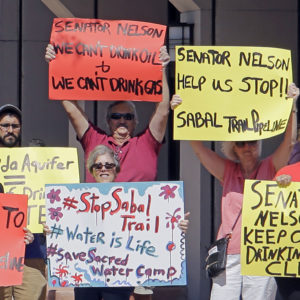Ten thousand people lived at the Sacred Stones, Oceti Sakowin, and Sicangu camps last summer trying to stop the Dakota Access Pipeline from crossing the Missouri River. Now the area is a moonlike landscape of gashed earth and burned structures. Construction workers are hurrying to make up for lost time. While the Standing Rock protest camps have been packed up and hauled away in hundreds of dumpsters, the protest’s influence lives on. The DAPL protests energized a new generation of environmental protesters, giving them a new set of tactics and fresh messaging to use against pipeline construction. The Standing Rock legacy can particularly be seen in Texas and Florida.
“There are now hundreds of scenes spread across North America. The protection of water, the rebalancing of the world, now has a symbol and a memory to carry that story forward,” says Mark Trahant, a professor of journalism at the University of North Dakota. “Every pipeline project that’s planned across North America will have to defend itself in every community, on social media, and with investors.”
Once the temperatures in North Dakota began plummeting, many protesters left the prairie protest camps in search of more hospitable climate. At the time, the Sacred Stones camp website directed them to ten other pipeline protests. One of the first pipeline protests to receive significant support from the Standing Rock protesters was Bayou Bride in Louisiana. Despite shouting down pro-pipeline speakers at a public hearing, the protesters have so far been unable to halt construction.
The Standing Rock legacy has had mixed success. In Texas, where the Native American-led groups have gathered to protest the Trans Pecos Pipeline, those who came arrived too late and found that the pipeline was practically complete.
When “water protectors” started arriving in December and early January, they consciously tried to adopt tactics from the Standing Rock protests.
“We saw what they did successfully. We’ve learned some of the logistics and tactics,” said 68-year-old Jesse Manciaz, a member of the Carrizo/Comecrudo Tribe of Texas. “The perspective from being Indian is that this land is sacred. Many see our land as real estate, but it’s more than that. It’s a living entity that’s being destroyed.”
However, the Trans Pecos protesters, like those at Standing Rock, found that they had begun their protest when the project was too close to completion. At the time, the pipeline was 90 percent complete and is slated to open this spring. Despite adopting environmental activist tactics such as locking themselves to the pipeline to halt construction, it was too little, too late.
The situation is similar in Florida, where activists have been trying stir up sufficient outrage to halt the Sabal Trail pipeline since the fall. They adopted the Standing Rock model, building a protest camp, the Crystal Water Camp, to house protesters who will watch the pipeline construction looking for environmental violations. They are also protesting to try to persuade Sen. Bill Nelson to take action against the project.
While the camp mimics the techniques of the DAPL protesters, it is nowhere near Sacred Stones’ size. Only a handful of tents have been erected in Florida.
The Sabal Trail protesters have adopted some of the native religion arguments used at Standing Rock. Tina Elmore-Wright, a member of the Seminole tribe, has sued the company, arguing that the construction of the pipeline defaced the land, making it impossible for her to bury her father.
She wished to bury her father near Station Pond, with other tribe members. Pipeline construction, she claims, has desecrated the area.
“Station Pond was chosen because, when not in drought, it connects to the Gulf of Mexico,” Elmore-Wright said.
She said the location is also where her mother’s ashes were scattered five years ago. However, the land was purchased from another tribe member by the Sabal Trail Pipeline company. The company is apologetic, but says that there is little they can do.
“Unfortunately, the [previous owner] refused to communicate any of his concerns to Sabal Trail until construction was started,” said Andrea Grover
“Even at this juncture, Sabal Trail has attempted to work with [Koon] and redirect construction work in conjunction with the FERC representative to reduce the workspace impacts in particular areas near where he noted particular concerns not related to his claims today,” Grover said.
The protesters have also been getting attention through more traditional protest techniques.
On Thursday, two protesters were arrested for climbing into a piece of the pipeline. The pair refused to leave when asked and locked themselves together to make their extraction by law enforcement more difficult. In a statement they posted to Facebook, the two made it clear that they considered all energy development environmentally harmful.
“We are taking action against the Sabal Trail pipeline because we don’t need more energy infrastructure poisoning this land,” the protesters said. “The world and our future generations are at risk, so we are demanding the immediate halt to this toxic project.”
Despite protesters’ efforts, construction on the pipeline has continued. According to an estimate from a Sabal Trail spokeperson, the project is set to begin operation in June. Ninety-seven percent of the route has been cleared and graded, 75 percent of the pipe has been placed in the ground, and cleanup has started on over 36 percent of the route where the pipeline has been completed.

